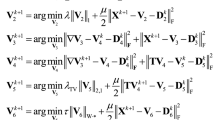Abstract
Linear unmixing decomposes a hyperspectral image into a collection of reflectance spectra of the materials present in the scene, called endmember signatures, and the corresponding abundance fractions at each pixel in a spatial area of interest.
This paper introduces a new unmixing method, called Dependent Component Analysis (DECA), which overcomes the limitations of unmixing methods based on Independent Component Analysis (ICA) and on geometrical properties of hyperspectral data.
DECA models the abundance fractions as mixtures of Dirichlet densities, thus enforcing the constraints on abundance fractions imposed by the acquisition process, namely non-negativity and constant sum. The mixing matrix is inferred by a generalized expectation-maximization (GEM) type algorithm. The performance of the method is illustrated using simulated and real data.
Preview
Unable to display preview. Download preview PDF.
Similar content being viewed by others
References
Lillesand, T., Kiefer, R., Chipman, J.: Remote Sensing and Image Interpretation, 5th edn. John Wiley & Sons, Inc., New York (2004)
Keshava, N., Mustard, J.: Spectral unmixing. IEEE Sig. Proc. Mag. 19(1), 44–57 (2002)
Nascimento, J., Dias, J.: Vertex component analysis: A fast algorithm to unmix hyperspectral data. IEEE Trans. Geosci. Rem. Sens. 43(4), 898–910 (2005)
Boardman, J.: Automating spectral unmixing of AVIRIS data using convex geometry concepts. In: JPL Pub. 93-26, AVIRIS Workshop, vol. 1, pp. 11–14 (1993)
Winter, M.: N-findr: an algorithm for fast autonomous spectral end-member determination in hyperspectral data. In: SPIE, vol. 3753, pp. 266–275 (2005)
Tu, T.: Unsupervised signature extraction and separation in hyperspectral images: A noise-adjusted fast independent component analysis approach. Opt. Eng. of SPIE 39(4), 897–906 (2000)
Lennon, M., Mouchot, M., Mercier, G., Hubert-Moy, L.: Spectral unmixing of hyperspectral images with the independent component analysis and wavelet packets. In: Proc. of IEEE IGARSS (2001)
Parra, L., Mueller, K., Spence, C., Ziehe, A., Sajda, P.: Unmixing hyperspectral data. In: Advances in Neural Information Processing Systems, vol. 12, pp. 942–948 (2000)
Nascimento, J., Dias, J.: Does independent component analysis play a role in unmixing hyperspectral data? IEEE Trans. Geosci. Rem. Sens. 43(1), 175–187 (2005)
Attias, H.: Independent factor analysis. Neural Computation 11(4), 803–851 (1999)
Moulines, E., Cardoso, J., Gassiat, E.: Maximum likelihood for blind separation and deconvolution of noisy signals using mixture models. In: Proc. of the IEEE ICASSP, vol. 5, pp. 3617–3620 (1997)
Nascimento, J., Dias, J.: Signal subspace identification in hyperspectral linear mixtures. In: Marques, J.S., Pérez de la Blanca, N., Pina, P. (eds.) IbPRIA 2005. LNCS, vol. 3523, pp. 207–214. Springer, Heidelberg (2005)
McLachlan, G., Peel, D.: Finite Mixture Models. John Wiley & Sons, Inc., New York (2000)
McLachlan, G., Krishnan, T.: The EM Algorithm and Extensions. John Wiley & Sons, Inc., New York (1996)
Lange, K.: Optimization, 1st edn. Springer, Heidelberg (2004)
Dias, J.: An EM algorithm for the estimation of dirichlet parameters. Technical report, Instituto de Telecomunicações (2005), http://www.lx.it.pt/~bioucas/
Nascimento, J., Dias, J.: Unmixing Hyperspectral Data: Independent and Dependent Component Analysis. In: Hyperspectral Data Exploitation: Theory and Applications (in press), John Wiley & Sons, Inc., Chichester (2006)
Minka, T.: Estimating a dirichlet distribution. Technical report, M.I.T. (2000)
Swayze, G., Clark, R., Sutley, S., Gallagher, A.: Ground-truthing aviris mineral mapping at cuprite, nevada. JPL Pub. AVIRIS Workshop 1, 47–49 (1992)
Author information
Authors and Affiliations
Editor information
Rights and permissions
Copyright information
© 2007 Springer Berlin Heidelberg
About this paper
Cite this paper
Nascimento, J.M.P., Bioucas-Dias, J.M. (2007). Dependent Component Analysis: A Hyperspectral Unmixing Algorithm. In: Martí, J., Benedí, J.M., Mendonça, A.M., Serrat, J. (eds) Pattern Recognition and Image Analysis. IbPRIA 2007. Lecture Notes in Computer Science, vol 4478. Springer, Berlin, Heidelberg. https://doi.org/10.1007/978-3-540-72849-8_77
Download citation
DOI: https://doi.org/10.1007/978-3-540-72849-8_77
Publisher Name: Springer, Berlin, Heidelberg
Print ISBN: 978-3-540-72848-1
Online ISBN: 978-3-540-72849-8
eBook Packages: Computer ScienceComputer Science (R0)




